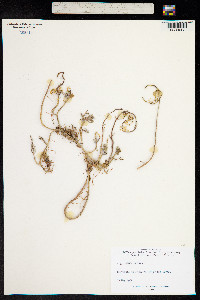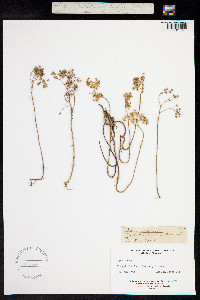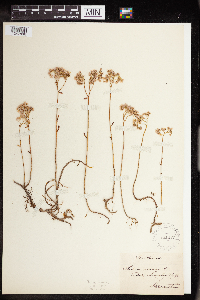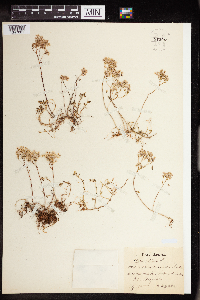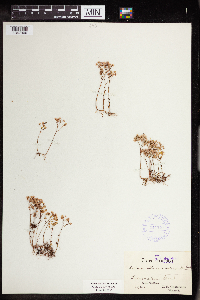Sedum album
|
|
|
|
Family: Crassulaceae
White Stonecrop
|
Herbs, perennial, laxly cespitose, minutely puberulent, papillose. Stems creeping and short-ascending, much-branched, (densely glandular-pubescent basally), not bearing rosettes. Leaves alternate, patent or appressed, sessile; blade green, often reddish, not glaucous, linear to ovate, subterete but adaxial surface somewhat flattened, 4-20(-25) × 1-20 mm, base scarcely spurred, not scarious, apex obtuse or rounded, (surfaces glabrous or sparsely hairy). Flowering shoots erect, simple or branched, 5-18(-30) cm, (glabrous or sparsely hairy); leaf blades linear to ovate, base scarcely spurred; offsets not formed. Inflorescences paniculate cymes, 15- 50+-flowered, 3-5-branched; branches reflexed, forked; bracts similar to leaves, smaller. Pedicels 3-5 mm. Flowers 5-merous; sepals erect, connate basally, green, ovate to triangular, equal, 0.5-1.5 × 0.2-0.5 mm, apex acute, (glabrous or sparsely and minutely puberulent); petals spreading, distinct, white or rarely pink, lanceolate, not carinate, 2-4.5 mm, apex subacute; filaments white; anthers red; nectar scales white or yellow, spatulate. Carpels erect in fruit, distinct, whitish. 2n = 34, 51, 68, 85, 102, 136. Flowering summer-fall. Calcareous rock ledges, gravelly flat areas, ruderal areas; 60-1400 m; introduced; B.C., N.B., Ont., Que.; Calif., Ind., Maine, Mich., N.J., N.Y., Ohio, Oreg., Pa., Utah, Wash., W.Va.; Europe. Sedum album was first reported as naturalized in the United States in 1934.
Perennial herb 10 - 30 cm tall Stem: creeping, forming a nearly circular mat 5 - 20 cm across. The flowering stems are ascending. Leaves: alternate, evergreen, 0.6 - 1.5 cm long, oblong to oval with a blunt tip and a tiny spur at the base, nearly circular in cross-section, succulent. Flowers: borne on a dense convex or flat-topped inflorescence 1.5 - 7 cm across. The five sepals are about 1 mm long, inversely egg-shaped, and lack spurs at the base, while the five petals are white to pinkish, 3 - 4 mm long, and broadly lance-shaped to inversely egg-shaped. Fruit: an erect, pink follicle 3 - 4 mm long. Similar species: Sedum alboroseum, Sedum album, Sedum purpureum, Sedum spurium, and Sedum ternatum have white to pink or purple flowers. Sedum alboroseum, S. purpureum, S. spurium, and S. ternatum are all flat in cross-section, making Sedum album easy to distinguish from the others. Flowering: late June to late July Habitat and ecology: Introduced from Eurasia, this species naturalizes in sandy areas. It is often found in cemetaries and along bike trails. Occurence in the Chicago region: non-native Etymology: Sedum comes from the Latin word sedo, meaning "to sit," referring to the manner in which some species attach to walls and rocks. Album means white. Author: The Morton Arboretum Fibrous-rooted perennial from creeping stems, forming mats with more erect flowering stems 1-2 dm; lvs alternate, subterete, 0.6-1.5 cm, obtuse, scarcely spurred at base; infl convex, rather dense, repeatedly branched; fls mostly 5-merous; pet white, 3-4 mm; frs pink, erect; 2n=68, 136. Native of Eurasia, sometimes escaped from cult. June, July. Gleason, Henry A. & Cronquist, Arthur J. 1991. Manual of vascular plants of northeastern United States and adjacent Canada. lxxv + 910 pp. ©The New York Botanical Garden. All rights reserved. Used by permission. |
























































